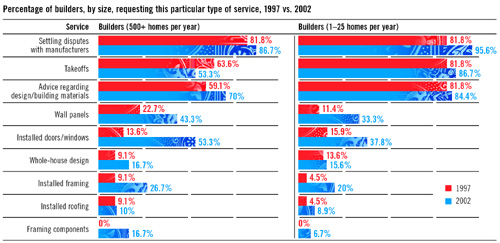With that, production builders are less attracted to “free” services, making them an even greater revenue drain on a dealer. “These aren’t the services that national builders would necessarily value [because] they have those capabilities in-house,” Baker says.
In addition to an increasing number of dealers offering just-in-time delivery, installed sales, and component manufacturing to maintain or capture more sales to large-volume builders, leading suppliers are upping the ante. “Builders are asking how they can have more turnkey kinds of services to impact their overall profitability,” says Dick Rose, a member of the JCHS advisory board and the senior vice president of logistics for Raleigh, N.C.–based Stock Building Supply, the country’s largest residential construction supplier with more than 220 locations and nearly $2.6 billion in annual revenue.
Premium services include purchasing and coordination beyond the LBM ticket, such as wrangling framers and other subcontractors and coordinating an agreed schedule for deliveries and services. “It’s more formalized than ever, and it’s happening more because it helps overall supply-chain management,” which results in faster cycle times and lower costs for Stock’s builder customers—two critical elements of their profitability, Rose says.
Both builders and dealers, however, admit that such a model only flourishes, or is only necessary, when there is pressure on dealers to change. “A dealer’s services depend on the competitive conditions [in the market] and who is buying the material,” says Heimbinder. “You have to figure out your customer base and how to serve them before you can know what ‘full service’ is and what it looks like [for that market].”
Among its vast supply-chain operations, Lanoga Corp., a $1.95 billion dealer network based in Redmond, Wash., is dedicated to serving big builders where they dominate the market. In Denver and Indianapolis, for instance, production builders make up more than 80 percent of the housing production. “Our operations there need the capacity, the speed, and the reaction time that those builders require,” says Paul Hylbert, Lanoga’s president and CEO, and a member of the JCHS advisory board.
Properly aligned with a given market’s needs, say Baker and others, a dealer’s mix of services will be the key to surviving direct-purchase relationships between builders and manufacturers. “Manufacturers really don’t want to pick up the service function [of delivering products to builders],” Baker says. “As logistics specialists, dealers can provide contracted services to both manufacturers and builders.”
Lean Retailing As the pressures mount on builders—and subsequently dealers—to maintain profitability in a more competitive housing world, the ability to remove costs from the supply channel becomes critical. In the JCHS report, this vision is called “lean retailing,” or the ability to communicate and integrate real-time product demand and inventory information along the entire supply chain. “It eliminates the risk of holding inventory while still having the right product for the customer when he needs it,” a process among dealers that currently relies more on guesswork than hard and timely numbers, says Weil.
That kind of capability, however, requires a complex web of integration, investments in technology, and a critical mass of participants—a model the current market is not yet embracing. “It’s where the [building materials] supply channel is headed, but it’s in flux in light of consolidation among builders,” says Baker.
It’s also likely that dealers will follow, not lead, the charge. “The initial drivers will be, for awhile, the major retailers,” namely The Home Depot and Lowe’s, says John Stelzer, director of industry development at Sterling Commerce, a technology consultancy in Dublin, Ohio.
The big boxes, says Stelzer, are already driving LBM and hardline distributors and major product manufacturers to comply with data synchronization standards; in turn, those upstream will seek to leverage their IT investments to smaller, pro-focused dealers.



